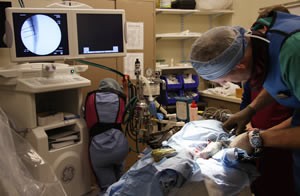 The University of Missouri Raptor Rehabilitation Project recently stepped in to help an American bald eagle that is a resident at a raptor facility in Illinois. Lincoln, who is approximately 7 years old, was discovered with a broken leg and an injured wing the morning of Jan. 28 at the Raptor Rehabilitation Center in Quincy, Ill. Workers at the center don’t know just when or how he injured himself, but they suspect that something prompted him to jump and the impact fractured his tibia.
The University of Missouri Raptor Rehabilitation Project recently stepped in to help an American bald eagle that is a resident at a raptor facility in Illinois. Lincoln, who is approximately 7 years old, was discovered with a broken leg and an injured wing the morning of Jan. 28 at the Raptor Rehabilitation Center in Quincy, Ill. Workers at the center don’t know just when or how he injured himself, but they suspect that something prompted him to jump and the impact fractured his tibia.
“Birds bones are different from mammalian bones and they are especially susceptible to breaks,” said Derek Fox, DVM, PhD, an assistant professor of small animal orthopaedic surgery at the MU Veterinary Health Center (VHC). “Our bones are more dense. Birds’ bones are strong, but they are brittle and they contain air. In the clinic we see two to three fractures each year for bald eagles, but we have two or more owls or red-tailed hawks every month.”
Staff at the Quincy Raptor Center contacted Fox and asked if he would be able to repair Lincoln’s broken leg. Although the not-for-profit center lacked funds to pay for the surgery, hospital administrators agreed that the injured eagle could be helped through a collaboration with the Mizzou Raptor Rehabilitation Project. The Raptor Rehabilitation Project is a service and education organization housed at the College of Veterinary Medicine. Veterinary students, community members and other MU students volunteer their time and effort in rehabilitating injured raptors and caring for resident birds. Volunteers also help raise public awareness by giving presentations about the ecological and cultural importance of birds of prey throughout mid-Missouri. The project is supported by the College and through private contributions.
The Quincy facility has a similar mission. Its staff also treats injured birds and returns them to the wild. However, when Lincoln was originally taken there he had an injury to his wing that prevents him from flying well enough to ever be released. He has been training to become one of the center’s educational program birds. Wrapped in a blanket and cradled by his handler to keep him calm, Lincoln was brought to the VHC Jan. 31 for surgery.
Fox was able to use a minimally invasive procedure to repair Lincoln’s leg. The availability of an intraoperative fluoroscopy — a type of intraoperative X-ray machine — at the VHC allowed Fox to use real-time imaging to insert a small rod down the center of the eagle’s tibia. He then connected the rod to an external fixator running down the outside of the bird’s leg using pins. Lincoln had also sustained an injury to his wing, possibly as a result of the stress of the fracture, which Fox sutured.
The procedure was a success and by Monday the swelling in Lincoln’s injured leg had decreased, he was able to use his leg to carry food and perch normally. He returned to his Quincy center home on Monday.
Fox said the collaboration helped not just the bird and its caretakers, but also provided a valuable learning opportunity for the College’s veterinary students and Raptor Project members who were able to witness and assist in the recuperation of a bald eagle.



